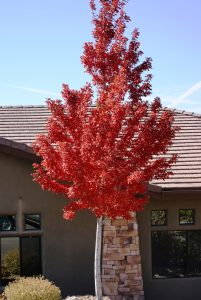by Ken Lain, the mountain gardener
 If your irrigation system’s water volume in October is the same as its volume for June, you need to change the timer settings. The length of time a tree needs to be watered in June is the same length of time that it should be watered in cool weather. What needs to be changed isn’t the length of time water runs, but the frequency of watering at each station. Irrigation cycles must water deeply to ensure that a plant’s entire root system receives adequate water; it just needs it less often. The amount of water needs to be increased only if plant size increases considerably.
If your irrigation system’s water volume in October is the same as its volume for June, you need to change the timer settings. The length of time a tree needs to be watered in June is the same length of time that it should be watered in cool weather. What needs to be changed isn’t the length of time water runs, but the frequency of watering at each station. Irrigation cycles must water deeply to ensure that a plant’s entire root system receives adequate water; it just needs it less often. The amount of water needs to be increased only if plant size increases considerably.
When programming an irrigation clock, you should be modifying how often each station cycles. Personally, I like using the station interval button instead of telling the clock which ‘Day of the Week’ to turn on my irrigation system. It doesn’t matter which day the clock runs; what matters is when the clock ran last and when it will come on again. I just changed my landscape trees and shrubs from a seven-day watering interval to every nine days. This results in a 23% savings of water consumption. Also, I changed my flowers from water every fourth day to being watered every five days.
Landscape companies like every other day watering schedule for newly planted yards. If your landscape is still on this heavy water cycle, this is a good time to change that frequency. Just be sure to maintain the same amount of water to encourage a deep root system. If you need help determining the right frequency for your landscape, ask for help from one of Watters ‘Plant Ambassadors’. I created a convenient mini watering guide that fits inside the covers of most irrigation clocks. It’s free the next time you visit us here at Watters Garden Center.
Autumn landscape colors are here! The high country of Arizona is famous for growing nice maples. If you plant the right variety it can require less care with fewer problems than the same tree in the New England states. Blaze Maple, Autumn Fantasy, Matador, and Celebration Maple are so at home in our area that I refer to them as ‘Prescott Maples’. They are going into autumn color now, their leaves glowing like embers in a blazing hot fire. These maples grow fast, love our soil, the area’s extreme weather conditions, and stand up to our wind better than other maple varieties. They are perfect for patios, hot sunny walls, driveways, and any place shade is needed. October is the ideal month to plant a large maple specimen. Get it rooted now and it will burst into vibrant life in spring.
Garden Caution – Many nursery and box stores have the Midwest Red Maple, Acer Rubrum, in stock. It does not perform well in local landscapes. If you are considering buying a tree from someplace other than Watters be sure to do your homework, or you won’t be happy 5 years from now. Make sure you know the source of the tree and that the growing advice you receive is for local success.
Most properties don’t have many trees. You actually can count on one hand the number of trees in the average landscape. Trees stand out in any landscape like anchors that bring together the foundation of a good plan. Also, don’t forget that trees increase the value of a home more than spas and grills.
If you are thinking of a new tree, don’t waste money by cutting corners. Trees are where the landscape value is and their purchase prices are no place to pinch pennies. Buy the best-looking tree you can find, the bigger the better. Nice looking trees at the garden center turn into big, bold specimens as they mature. An ugly tree stays ugly its entire life. Cut landscape dollars on shrubs, flowers, and hedges so your budget can afford a few specimen-sized trees to enhance your outdoor areas.

The most important plant feeding of the year is in October. Plants are like bears getting ready for their winter hibernation; for sustenance, they store up food in their roots like bears store up body fat. Plants use this food to create next spring’s flower and leaf buds.
This feeding is especially important for conifers to fend off damage from pinion pine scale and bark beetles. October feeding of conifers is critical to prevent damage this winter and promote better growth in the coming year. The secret to keeping evergreens green is the right plant food. They respond amazingly well to my specially formulated 7-4-4 “All Purpose Plant Food”.
Many native evergreens can come under attack by scale, bark beetles, borers, aphids, and grubs. So, make sure to include natives when feeding your landscape, as they will use this food to combat their natural enemies. Again, the 7-4-4 “All Purpose Plant Food” was intended for landscape ornamentals, but it works just effectively on the natives in our yards.
Until next week, I’ll be helping customers with the best fall-colored maples here at the garden center.
Ken Lain can be found throughout the week at Watters Garden Center, 1815 W. Iron Springs Rd in Prescott, or contacted through his web site at WattersGardenCenter.com or FB.com/WattersGardenCenter .


How long do maple trees live in the Prescott area We are the second owners of this house with a big beautiful maple out front. The tree is about 20 years old. I’m not sure where it was bought